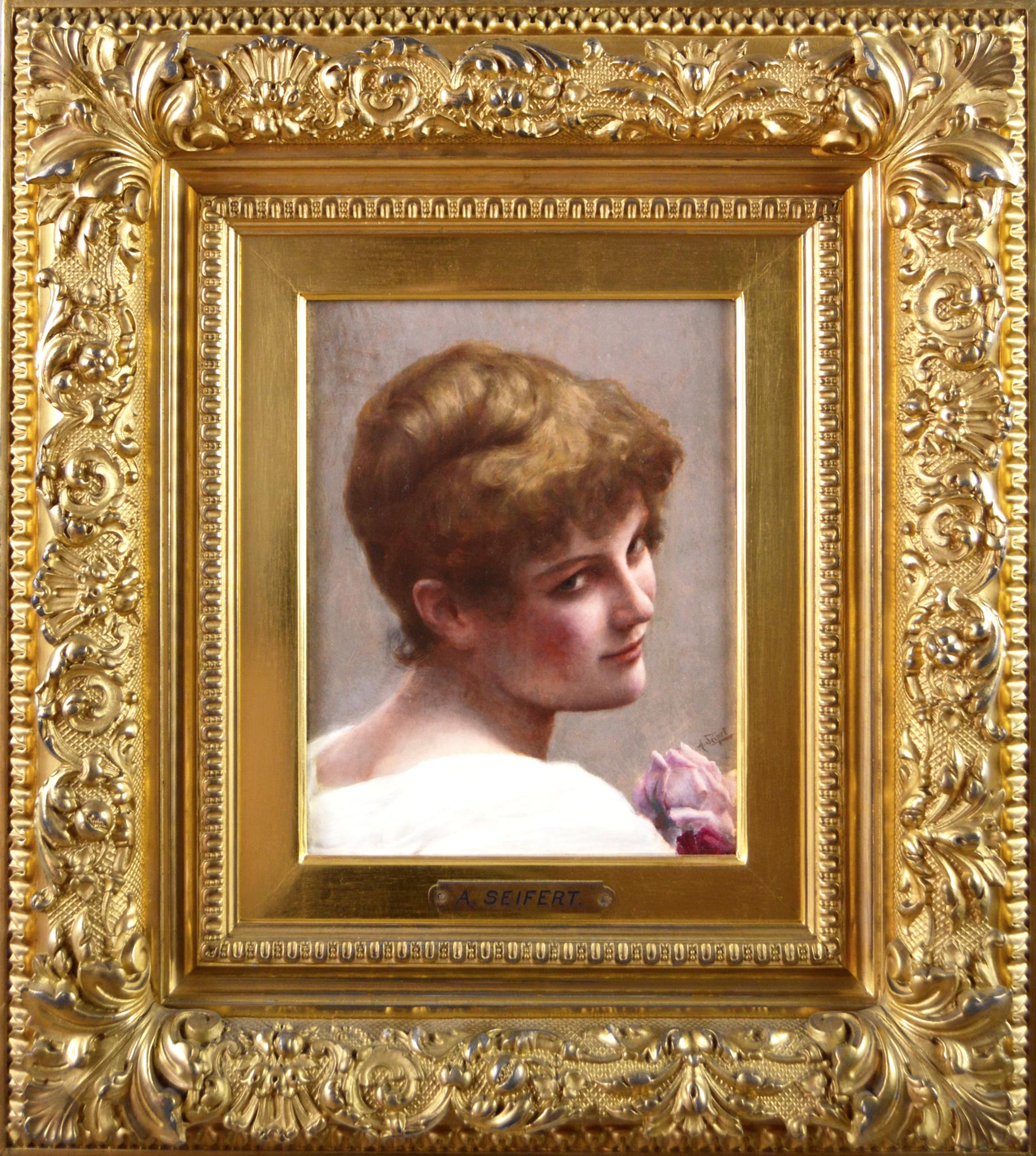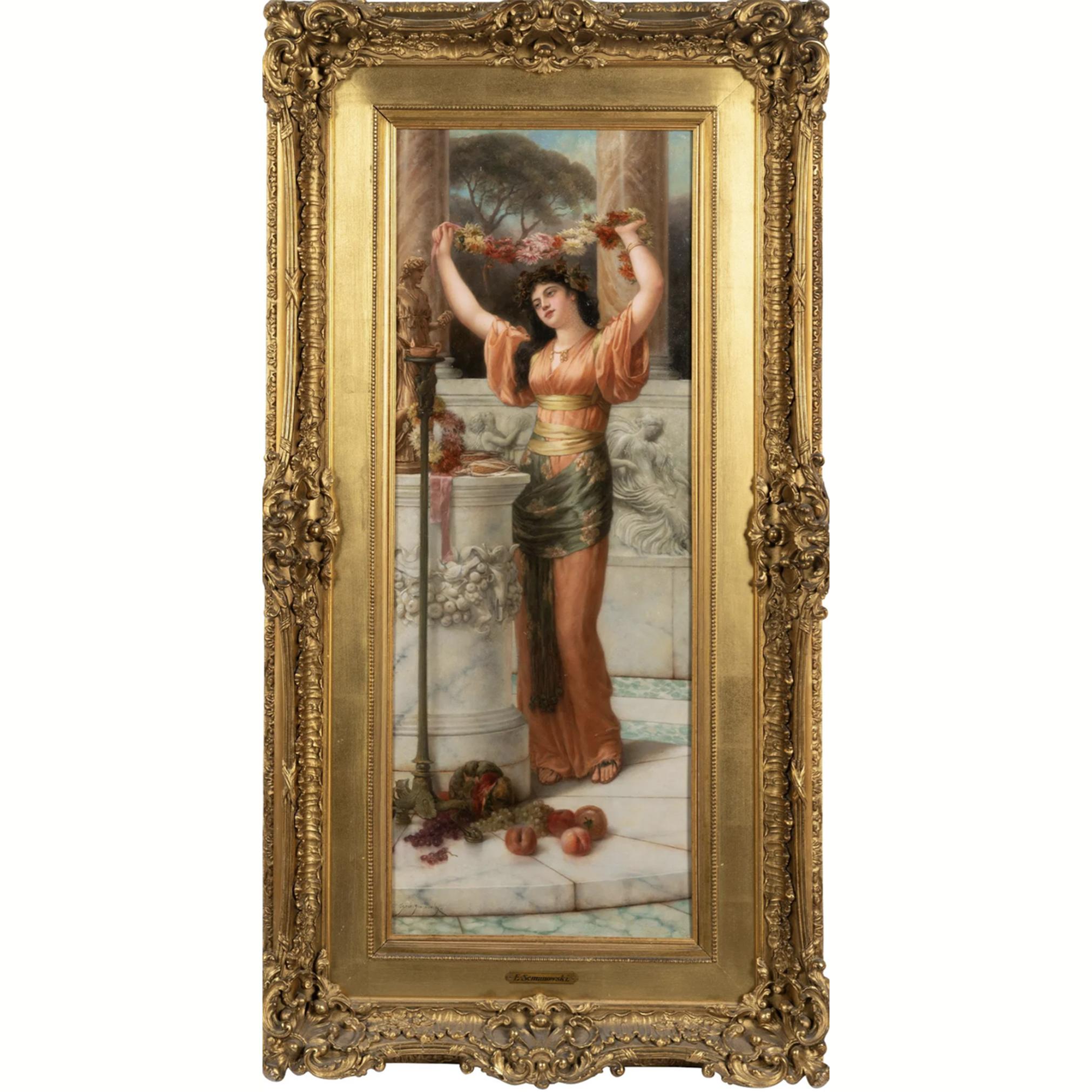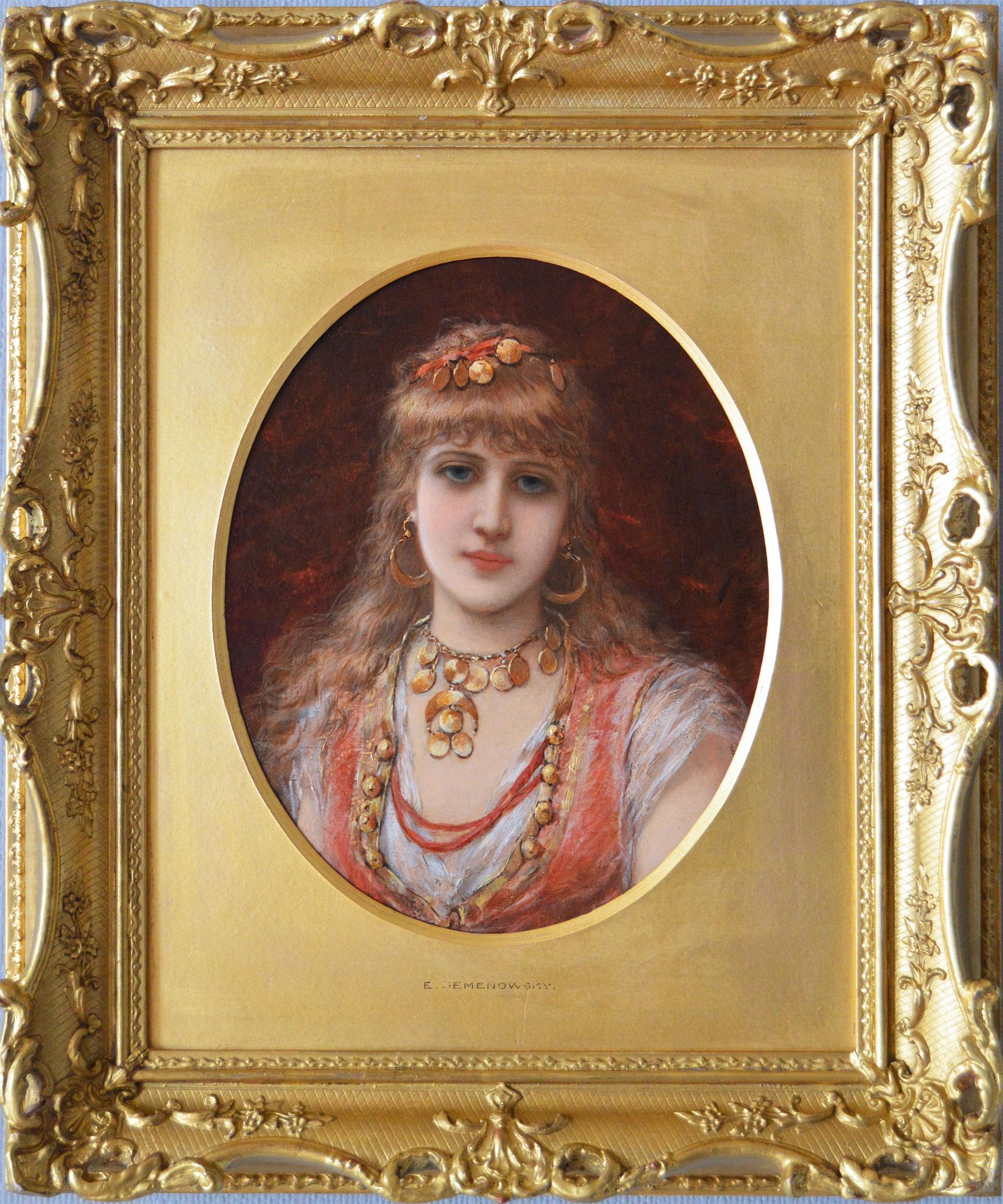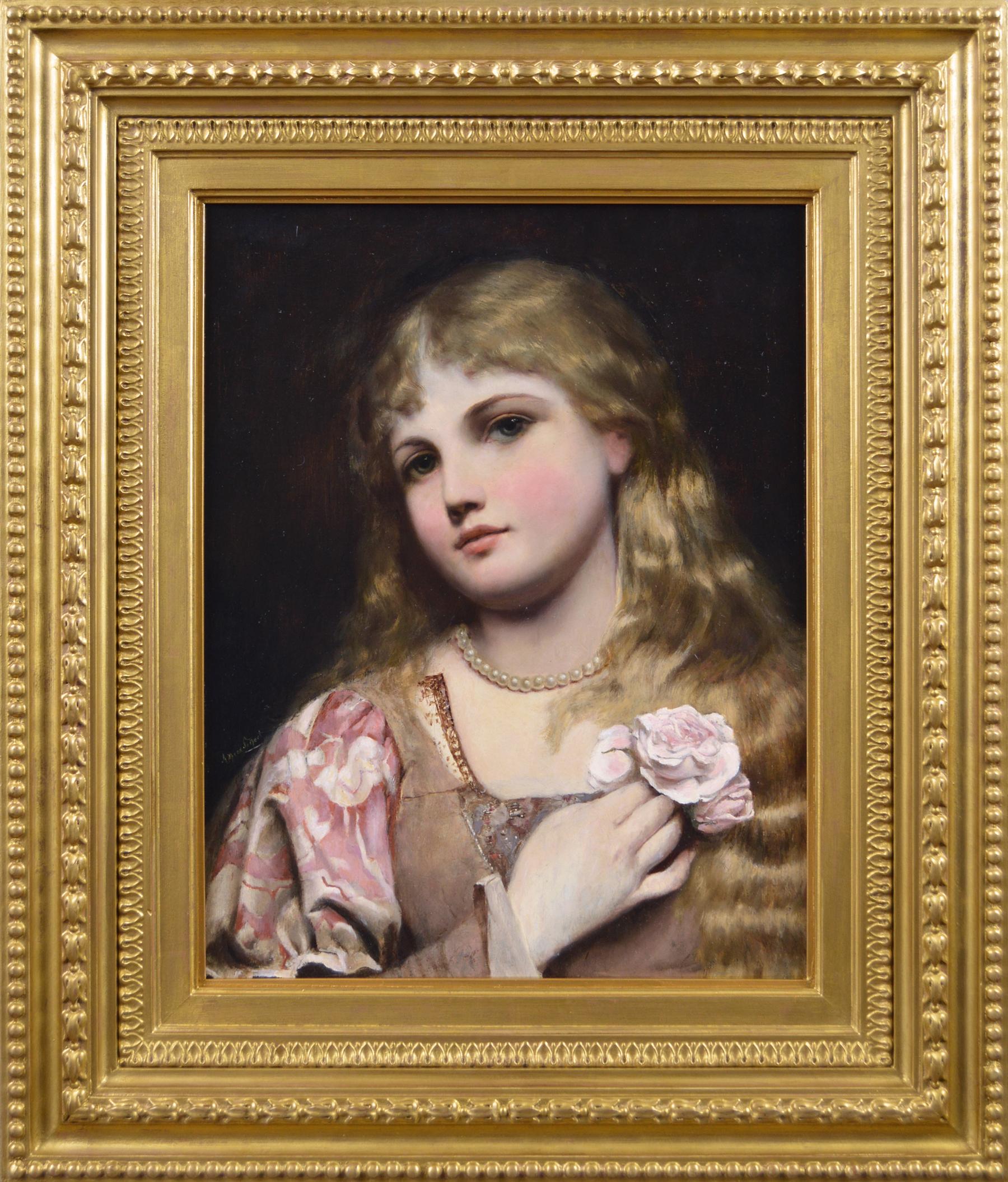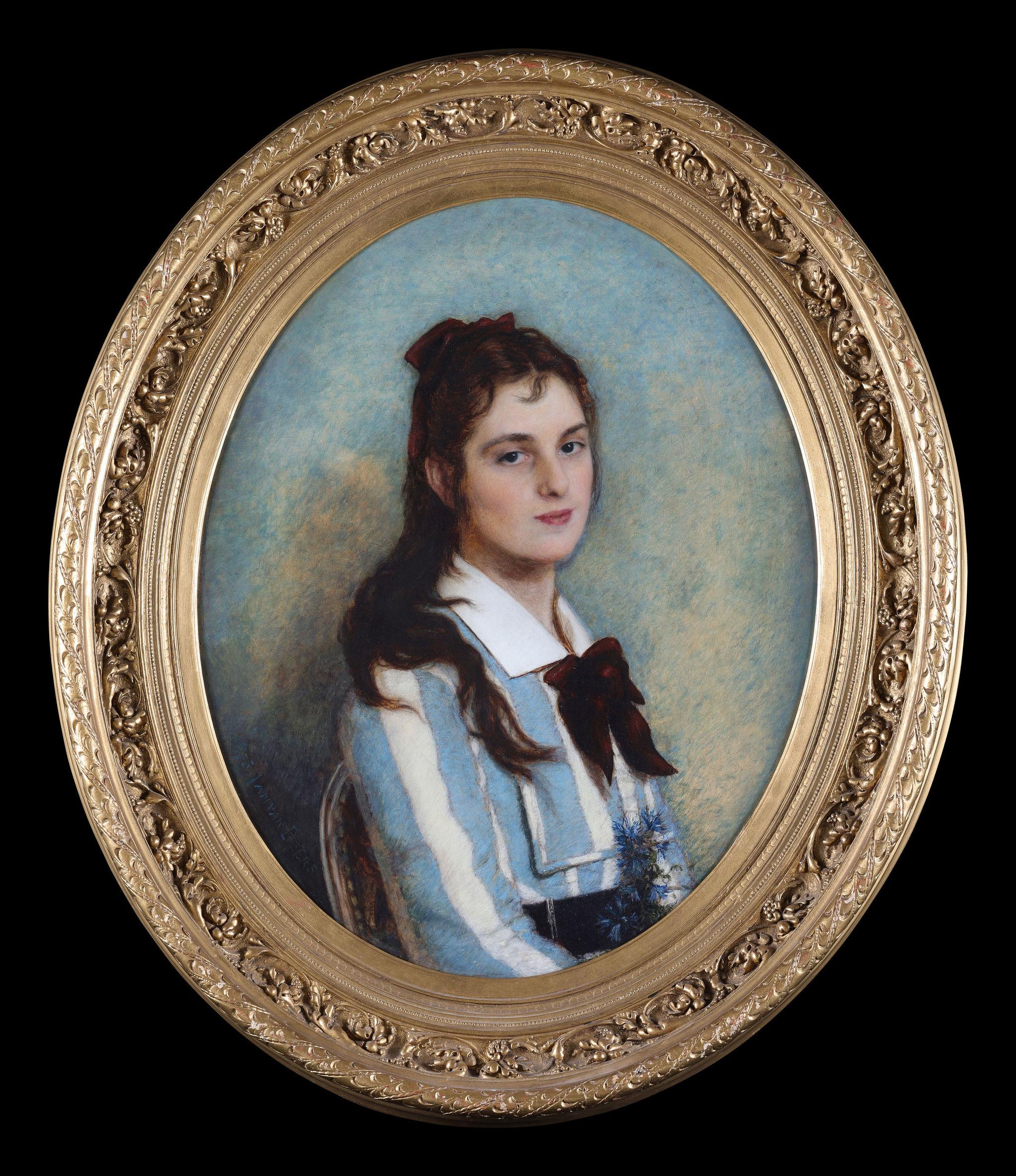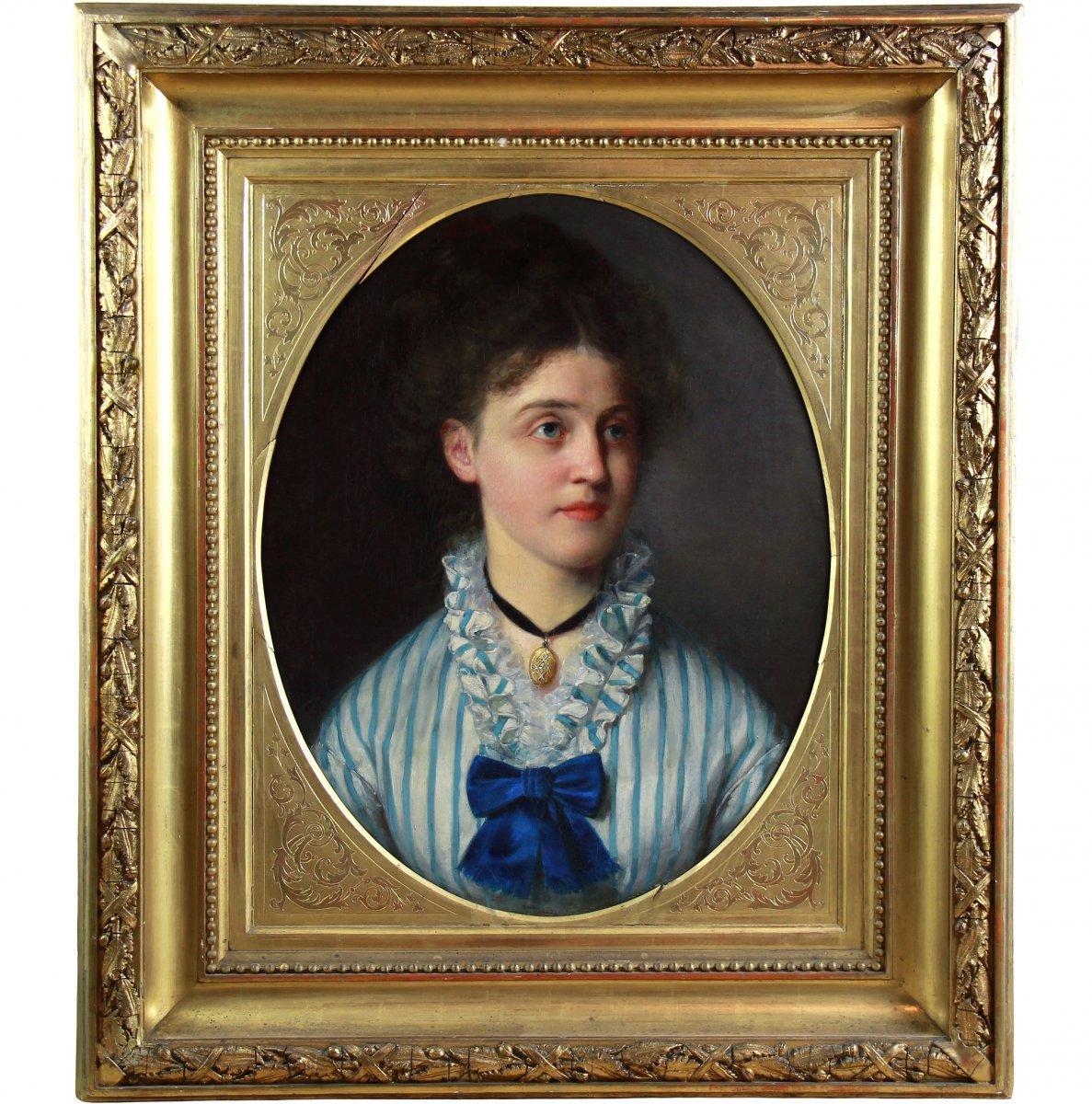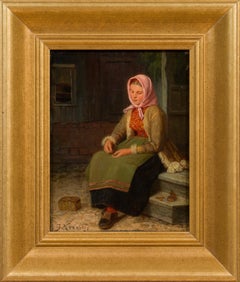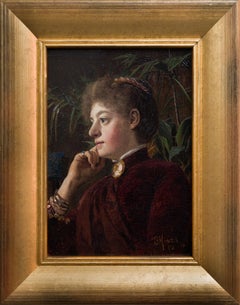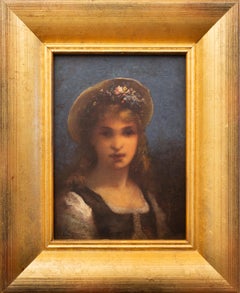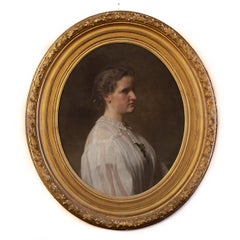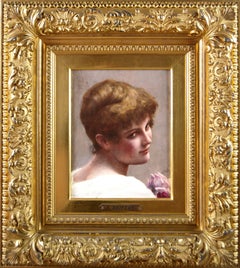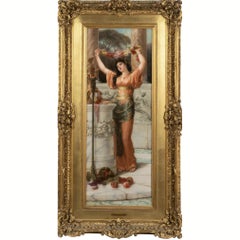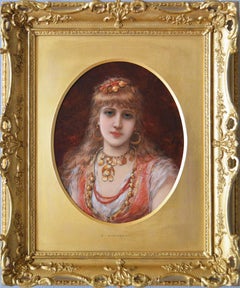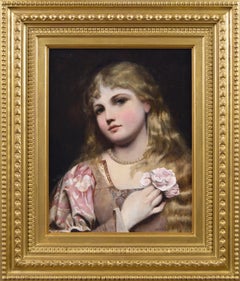Items Similar to Julius Kronberg’s Angelica – A Romantic Heroine of Renaissance Legend
Want more images or videos?
Request additional images or videos from the seller
1 of 12
Julius KronbergJulius Kronberg’s Angelica – A Romantic Heroine of Renaissance LegendLate 1800s
Late 1800s
$6,547.65
£4,866.68
€5,500
CA$9,040.50
A$10,025.25
CHF 5,267.53
MX$122,491.52
NOK 65,903.93
SEK 61,862.10
DKK 41,879.75
About the Item
Literary Origins of Angelica
The subject of this painting is Angelica, a princess from the epic chivalric romances of the Italian Renaissance. She first appears in Matteo Maria Boiardo’s Orlando Innamorato (1483) and reappears famously in Ludovico Ariosto’s Orlando Furioso (1532). In these poems – part of the Matter of France cycle of Charlemagne and his paladins – Angelica’s extraordinary beauty ensnares many knights, including Orlando (Roland) and his cousin Rinaldo, sparking rivalries and adventures. Ariosto’s narrative particularly highlights Angelica’s tumultuous journey: at one point she is stripped and chained to a rock as a sacrifice to a sea monster (a scene mirroring the myth of Andromeda) before being dramatically rescued by the valiant knight Ruggiero on his winged horse. Ultimately, however, Angelica chooses her own destiny. She falls in love with a humble Saracen soldier, Medoro, whom she nurses back to health, and she returns with him to her far-off Asian kingdom – an affair that drives the heartbroken Orlando to madness. This independent resolution (marrying outside the circle of Christian knights) made Angelica an emblem of feminine agency and romantic idealism in Renaissance literature. Her story remained popular in art and literature through the centuries, symbolizing the allure and elusiveness of love.
Kronberg’s Portrayal and Composition
In Julius Kronberg’s oil painting, Angelica is portrayed not in the throes of action but as a serenely self-possessed young woman. The composition is a half-length frontal portrait against a simple, warm-toned background. Angelica meets the viewer’s gaze directly with her large, luminous eyes and a faint, enigmatic smile. Her auburn hair is loosely draped by a dark band, framing a face rendered with smooth, delicate modeling. She wears a green gown decorated with subtle golden embroidery at the neckline, attire that hints at a Renaissance or exotic origin without specifying a particular scene. The backdrop is a rich deep red, a color that both complements the green of her garment and imbues the image with a romantic warmth. Kronberg’s handling of oil on panel is meticulous – the surface is finely blended and luminous, with soft glazes and gentle transitions that recall the finish of Old Master portraits. The lighting is even and caressing, creating a soft glow on Angelica’s skin and giving her an almost lifelike presence. This intimate and static presentation allows Angelica’s contemplative expression to become the focus, inviting the viewer to engage with her character and inner life.
Artistic Interpretation and Style
Kronberg’s interpretive choice to depict Angelica in a calm, introspective pose (rather than illustrating one of her dramatic ordeals) is telling. Instead of showing the princess in distress or in the company of her rescuers and lovers, he presents her in a timeless moment of repose. Angelica’s direct yet gentle gaze conveys a sense of quiet strength and dignity, which may be read as an allusion to her autonomous decision in the saga to follow her heart with Medoro. The painting’s tone is lyrical and nostalgic – the harmonious color palette of reds and emerald-greens and the elegant simplicity of the setting evoke the idealized world of Renaissance romance. In this way, Kronberg’s Angelica serves as both an homage to its literary source and a character study. The viewer, aware of Angelica’s story, might sense beneath her composed exterior the echoes of her adventures – the peril, passion, and resolve that define her narrative – yet the artwork remains deliberately focused on her beauty and calm expression. The result is a portrayal of Angelica as an almost archetypal romantic heroine: physically graceful, emotionally poised, and imbued with an air of poetic mystery.
Julius Kronberg’s Style and Oeuvre
Julius Kronberg was one of Sweden’s notable academic painters of the late 19th century, known for his historicist and decorative approach. Educated at the Royal Swedish Academy of Fine Arts in Stockholm, and influenced by his studies in Munich and Rome, Kronberg often drew on mythological, biblical, and literary subjects for his paintings. Many of his major works feature dramatic heroines or exotic themes drawn from what he viewed as the “Orient” or antiquity – for example, his canvases Cleopatra’s Death (1883), David and Saul (1883), The Queen of Sheba (1888), and Hypatia (1889) all demonstrate his penchant for Eastern history and legend. Angelica fits well into this oeuvre of romantic and historical subjects. Like those works, it reflects the 19th-century fascination with the Renaissance and the exotic; Angelica, as a princess of Cathay in a Renaissance epic, would have appealed to Kronberg’s interest in opulent literary themes. However, unlike the grand, theatrical compositions for which Kronberg was renowned, Angelica is painted on a small, intimate scale (40.5 x 32 cm) and focuses on psychological nuance over spectacle. The painting showcases Kronberg’s academic technique and refined style: the brushwork is smooth and precise, the forms are idealized, and the colors are rich and saturated, recalling the influence of the French academic and late Romantic painters. Kronberg had also been impressed by the sumptuous style of Hans Makart during his time in Munich, and in Angelica one can sense a similar love of vivid color and idealized form. Even in this modest portrait, Kronberg achieves a sense of timeless elegance, turning a literary character into a vision of beauty that would resonate with his contemporary audience’s nostalgia for the Renaissance.
oil on wood panel
signed J.Kronberg
unframed: 40.5 x 32 cm (15 7/8 x 12 5/8 in)
framed: 69 x 61 cm (27 1/8 x 24 in)
Condition: The painting has recently been examined by a professional art conservator, and the surface has been cleaned. The wooden panel is flat and stable. The painting is in very good condition. The original frame has a beautiful aged patina, with minor scuff marks and repairs.
Provenance:
The painting was originally with Fritzes Kungliga Hofbokhandel (Fritze’s Royal Court Bookshop) in Stockholm, a prestigious bookseller to the Swedish royal household that also dealt in high-quality art publications and the sale of select artworks. It was later owned by the Swedish chemical engineer and inventor Arthur Ramén of Helsingborg and remained in his family by descent.
- Creator:Julius Kronberg (1850 - 1921, Swedish)
- Creation Year:Late 1800s
- Dimensions:Height: 27.17 in (69 cm)Width: 24.02 in (61 cm)
- Medium:
- Movement & Style:
- Period:
- Condition:The painting has recently been examined by a professional art conservator, and the surface has been cleaned. The wooden panel is flat and stable. The painting is in very good condition. The original frame has a beautiful aged patina, with minor flaws.
- Gallery Location:Stockholm, SE
- Reference Number:1stDibs: LU1445216139572
About the Seller
5.0
Platinum Seller
Premium sellers with a 4.7+ rating and 24-hour response times
Established in 2020
1stDibs seller since 2020
196 sales on 1stDibs
Typical response time: <1 hour
Associations
International Confederation of Art and Antique Dealers' Associations
- ShippingRetrieving quote...Shipping from: Stockholm, Sweden
- Return Policy
Authenticity Guarantee
In the unlikely event there’s an issue with an item’s authenticity, contact us within 1 year for a full refund. DetailsMoney-Back Guarantee
If your item is not as described, is damaged in transit, or does not arrive, contact us within 7 days for a full refund. Details24-Hour Cancellation
You have a 24-hour grace period in which to reconsider your purchase, with no questions asked.Vetted Professional Sellers
Our world-class sellers must adhere to strict standards for service and quality, maintaining the integrity of our listings.Price-Match Guarantee
If you find that a seller listed the same item for a lower price elsewhere, we’ll match it.Trusted Global Delivery
Our best-in-class carrier network provides specialized shipping options worldwide, including custom delivery.More From This Seller
View AllThe Poor Girl – An Early Genre Scene by Julius Kronberg, 1873
Located in Stockholm, SE
This small, tenderly rendered painting— titled The Poor Girl (Den fattiga flickan)—offers a rare glimpse into Julius Kronberg’s early period, when he w...
Category
1870s Realist Figurative Paintings
Materials
Canvas, Oil
Portrait of a Girl, 1887 by Danish Realist Painter Peder Mørk Mønsted
By Peder Mørk Mønsted
Located in Stockholm, SE
This painting titled "Portrait of a Girl" by the Danish realist painter Peder Mørk Mønsted captures an enigmatic young woman whose identity remains unknown. The girl, elegantly posed...
Category
1880s Realist Portrait Paintings
Materials
Oil, Wood Panel
French Girl with Flowered Hat with Impressive Sfumato Technic by Leon Richet
By Leon Richet
Located in Stockholm, SE
Introducing a stunning portrait by renowned French artist Léon Richet (1847-1907), depicting a young girl adorned with a beautiful floral wreath and a hat perched atop her head. This...
Category
Late 19th Century Barbizon School Portrait Paintings
Materials
Oil, Panel
Portrait of Alice Ritter by Ferdinand Fagerlin. Oil on Canvas
Located in Stockholm, SE
Ferdinand Fagerlin (1825-1907) Sweden
Portrait of Alice Ritter, The Artists Wife
oil on canvas
signed with monogram
painted 1862
canvas size 27.95...
Category
1860s Portrait Paintings
Materials
Canvas, Oil
$4,285 Sale Price
20% Off
Young Girl Watering Flowers – Intimate 19th Century Genre Scene
Located in Stockholm, SE
This tender scene by German artist Georg Buchner captures a quiet, intimate moment: a young girl carefully watering a potted plant on a windowsill. The warm light gently illuminates ...
Category
Late 19th Century Realist Figurative Paintings
Materials
Oil, Wood Panel
A Young Woman With Her Dog by Victor Ravet
Located in Stockholm, SE
In this exquisite painting by Victor Ravet, we are transported to an elegant interior setting reminiscent of the grandeur of high-class homes. The focal point is a woman adorned in a shimmering pink gown, radiating grace and sophistication. Bathed in gentle light, her dress catches the glimmer, accentuating her beauty.
She holds a treat for a dog in her hand, enticing the furry companion who stands on its hind legs in eager anticipation. The canine's eyes fixated on the delicious morsel, capturing a moment of playful interaction between the woman and her loyal companion.
The scene takes on a narrative quality as the young woman's other hand delicately lifts a curtain, hinting at another room beyond. This subtle gesture adds depth to the composition, suggesting a world of hidden secrets and intriguing possibilities within the opulent surroundings.
Victor Ravet took inspiration from the Dutch Golden Age painters of the 17th century, such as Vermeer, Jacob Ochtervelt, and Gerrit Dou. This homage to their style and subject matter pays tribute to the timeless allure of domestic scenes, capturing a slice of life in a bygone era.
With meticulous attention to detail, Ravet masterfully recreates the textures and fabrics, immersing the viewer in the sumptuousness of the period. The soft play...
Category
1870s Realist Interior Paintings
Materials
Oil, Panel
You May Also Like
19th Century portrait oil painting of a young woman with a rose
By Alfred Seifert
Located in Nr Broadway, Worcestershire
Alfred Seifert
Czech, (1850-1901)
Portrait of a Young Woman with a Rose
Oil on panel, signed
Image size: 10.5 inches x 8.25 inches
Size including frame: 22 inches x 19.75 inches
...
Category
19th Century Portrait Paintings
Materials
Oil, Panel
Painting of a Beauty by Emile Eisman-Semenowsky (Russian, 1857-1911)
By Émile Eisman-Semenowsky
Located in New York, NY
A Beauty with a Chrysanthemum Garland
signed Eisman-Semenowsky (lower left)
Artist: Emile Eisman-Semenowsky (Russian, 1857-1911)
Medium: oil on panel
Frame: 44 1/4 x 23 inches.
Category
19th Century Figurative Paintings
Materials
Oil, Panel
19th Century portrait oil painting of young woman
By Émile Eisman-Semenowsky
Located in Nr Broadway, Worcestershire
Émile Eisman-Semenowsky
French/Polish, (1857-1911)
Eastern Beauty
Oil on panel, oval, signed & inscribed Paris
Image size: 10.25 inches x 8.25 inches (oval)
Size including frame: 18...
Category
19th Century Portrait Paintings
Materials
Oil, Panel
19th Century portrait oil painting of a young woman with pearls & a rose
By Alfred Seifert
Located in Nr Broadway, Worcestershire
Alfred Seifert
Czech, (1850-1901)
Portrait of a Young Woman with a Pearl Necklace & Rose
Oil on panel, signed
Image size: 15.5 inches x 12 inches
Size including frame: 23 inches x...
Category
19th Century Victorian Portrait Paintings
Materials
Oil, Panel
The Beautiful Maiden
By Jan Van Beers
Located in St. Albans, GB
Jean Marie Constantin Joseph (Jan) VAN BEERS
Oil on Panel
Panel Size: 32 x 24" (81 x 62cm)
Outside frame Size: 38 x 33" (97 x 83cm)
Van Beers (1852 ...
Category
1870s French School Figurative Paintings
Materials
Oil
Oil On Canvas Portrait Of A Young Lady 19th century
Located in Gavere, BE
Oil On Canvas Portrait Of A Young Lady 19th century
dated and signed 1874 ( Portrait of the artist's daughter )
Henri-Guillaume Schlesinger, originally Wilhelm Heinrich Schlesinger...
Category
1870s French School Portrait Paintings
Materials
Gold Leaf
$10,952 Sale Price
20% Off
More Ways To Browse
French Renaissance Art
French Renaissance Painting
Old Masters Renaissance Paintings
Renaissance Wood Panels
19th French Portrait Woman
Antique Red Wing
Antique Heart Mirror
19th Century Painting Lovers
5 Panel Mirror
Sea Monster
Painting On Wood 1800s
Han Horse
Soldier Horse Painting
Portrait Embroidery
Renaissance Embroidery
Painted Rocking Horse
Large Rocking Horse
Antique Nurses
